
Part 2. Peculiarities of China's Foreign Policy in New Geopolitical Conditions
Part 1. “Cherishing his old knowledge, so as continually to be acquiring new, he may be a teacher of others)” — Confucius
Oleksandr Lebid, a Military and Political Expert
The manifestation of Confucius' wisdom can also be found in China's current approaches to developing its foreign policy, which is aimed at strengthening the PRC's role in international relations.
Thus, modernizing and getting adapted to today's realities, but not changing the original essence, the Chinese leadership continues to adhere to the principles of foreign policy that were worked out in the long history of China. The main such principles are as follows:
- the PRC's national interests have priority over any other foreign policy problems (a sort of “Sino-centrism”);
- foreign policy tasks are solved consistently and purposefully;
- there are no time limits for solving strategic tasks in foreign policy;
- international cooperation develops by adapting national interests to local laws and traditions to avoid conflicts;
- economic and sociocultural “absorption” of peoples that are involved in cooperation with China;
- emigration of the Chinese is encouraged.
These principles were taken into account at the very beginning of the Chinese reforms. It is possible that this is why Deng Xiaoping made the only right choice regarding the development of cooperation with developed countries, instead of strengthening ties with the former USSR. By doing so, China had the opportunity to establish pragmatic relations with most of the world and to create conditions for its own economic development.
Avoiding getting involved in any conflicts in the past more than thirty years, China, pursuing the goal of intensive economic development, has managed to build pragmatic relations with many countries. The strengthening of international positions predetermined the China's activeness in ensuring the stable development of the world economy in the face of the increasing turbulence in the West.
To implement national strategic interests, the official Beijing has focused its efforts in foreign policy on intensifying the PRC's activities on international platforms, as well as on pragmatic development of relations with the world's “centers of power”.
China's using international platforms involves activities in a number of spheres, the main of which are as follows:
- participation in the formation of an international agenda for economic development;
- formation of foreign partners' attitude to China as a reliable world leader;
- strengthening the PRC's multilateral cooperation with the countries of Europe and Asia;
- strengthening regional stability using the opportunities of the Shanghai Cooperation Organization.
Participation in shaping the international agenda of economic development is carried out by China using the opportunities of the G20. As part of its chairmanship in the Organization, at the G20 summit on September 4–5, 2016 in Hangzhou, the Chinese side put forward the initiative to create conditions for sustainable global economic growth. As you know, China's initiative was the call on the international community to create innovative, invigorated, interconnected and inclusive world economy. Formation of such an approach to the development of the world economy will allow developing countries to increase their share in global value chains, and China itself — to become the leader among developing countries.
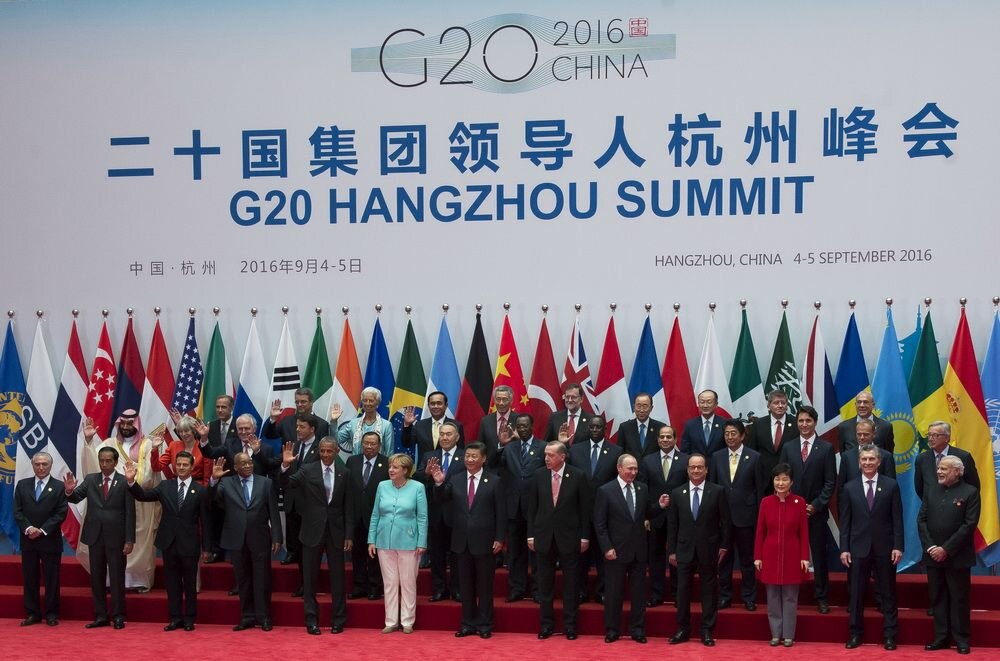
|
| G20 summit in Hangzhou, September 4–5, 2016 |
The Chinese initiatives were taken into consideration when organizing the informal meeting of the Foreign Ministers of the G20 countries on 16–17 February 2017 in Bonn (FRG). In particular, the meeting discussed the role of foreign policy in countering global challenges, as well as the possibility of building a peaceful and just world order. The fact that the FRG, as the state that took over the leadership in the Organization G20 from the PRC, is paying special attention to the Chinese initiatives is testified to by the talks between the Foreign Ministers of the FRG Z. Gabriel and PRC Wang Yi. This meeting should be regarded as the next stage in the development of the Sino-German strategic partnership. It should be noted that further cooperation between the PRC and the FRG depends on giving German business equal rights with Chinese entrepreneurs on the Chinese market. During the talks, Z. Gabriel drew the Chinese side's attention to the fact of Germany's being interested in that matter.
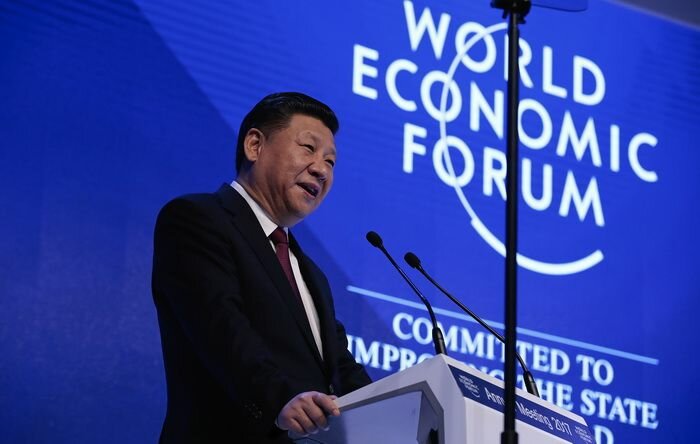
|
| Chinese President Xi Jinping speaks at the opening session of the World Economic Forum in Davos, January 17–20, 2017 |
While forming foreign partners' attitude to China as a reliable world leader, Beijing demonstrates a commitment to further development of world cooperation. Opening the World Economic Forum in Davos (January 17–20, 2017) held under the theme “Responsive and Responsible Leadership”, Xi Jinping actively advocated globalization, calling the main reasons for the crisis phenomena in the world the ill-considered foreign policy of influential countries.
In general, an analysis of Chinese leader's speech at the forum shows Beijing's being vitally interested in irreversibility of globalization, the development of which is threatened by political populists in the West, whose positions have got intensified today. The possibility of economic ties getting weaker as a result of the concentration of efforts by the United States and the EU countries to solve internal problems, is capable of destroying the positive dynamics of the development of China's economy, whose structure remains oriented toward external consumption.
Besides, Xi Jinping's speech against protectionism and any restrictions in international trade attested to the PRC's intention to continue active cooperation with Western countries and “penetration” into their economies in order to expand opportunities for China's development. The statement by the Chinese leader in Davos was a consistent step in implementing the initiative “to create innovative, invigorated, interconnected and inclusive world economy”, with which Beijing addressed the G20 summit in Hangzhou in 2016. By such steps, China intends to ensure the activities of the national economy outside the production stage in the “global value chains”, occupying new places in the pre-production and post-production stages. Also, Xi Jinping's participation in the Davos Forum was meant to demonstrate China's still being greatly interested in foreign investments, first of all for the development of high technology, and also the China’s ability to invest into economies of foreign countries. An analysis of the activities of the Chinese delegation at the Davos Forum makes it possible to assert that the participants of the Forum are interested in Beijing as a potential investor. In fact, the format and themes of the PRC's President's meetings can be regarded as a manifestation of China's ambitious intention to become one of the leaders of the global economic processes.
In turn, China lifts restrictions on the access to the Chinese stock market for the firms with foreign capital, which are allowed to issue securities in the PRC. The report on the work of the PRC's government, which was prepared before the 5th Session of the National People's Congress of the 12th convocation (held in March 2017), supported the introduction of administrative procedures for foreign investments (companies registered in the country) and permission for foreign companies to issue bonds, as well as to take part in scientific and technical programs and infrastructure projects.
 In order to strengthen multilateral cooperation with the countries of Europe and Asia, the PRC fully uses the Chinese geo-economic initiative “One Belt — One Road”. The concept of the implementation of this initiative was first presented by Xi Jinping during his visit to the countries of Central Asia and to Indonesia in 2013. The initiative provides for the development of economic and cultural ties between the developing and developed states of Eurasia, creating conditions for the developing economies' integration into global production relations. Simultaneously, China is strengthening cultural ties with countries that are invited to implement the project “One Belt — One Road”, which helps to prevent the emergence of contentious issues in relationships.
In order to strengthen multilateral cooperation with the countries of Europe and Asia, the PRC fully uses the Chinese geo-economic initiative “One Belt — One Road”. The concept of the implementation of this initiative was first presented by Xi Jinping during his visit to the countries of Central Asia and to Indonesia in 2013. The initiative provides for the development of economic and cultural ties between the developing and developed states of Eurasia, creating conditions for the developing economies' integration into global production relations. Simultaneously, China is strengthening cultural ties with countries that are invited to implement the project “One Belt — One Road”, which helps to prevent the emergence of contentious issues in relationships.
Since the announcement of the initiative, about 40 countries have signed an agreement with the PRC on cooperation on the basis of full consensus. In total, more than 100 countries and international organizations have announced their participation.
The next stage of the initiative was the “One Belt — One Road” Forum, which took place in Beijing on 14–15 May 2017, and gathered about 1500 representatives from 130 countries, including 29 foreign heads of state. Such a number of forum participants became a demonstration of the high efficiency of the current leadership of China's application of the principles of foreign policy pursued by Chinese leaders in the distant past. Opening the Forum, President Xi Jinping announced his desire to contribute to the creation of “...a new model of international mutually beneficial cooperation,” in which China refrains from interfering “...with the internal affairs of other states”. According to the Chinese leader, “the countries should respect sovereignty, territorial integrity, specifics of social development, fundamental interests and each other's concerns”. Demonstration of the lack of claims, along with the enormous economic potential, provided the Chinese initiative with serious international attention.
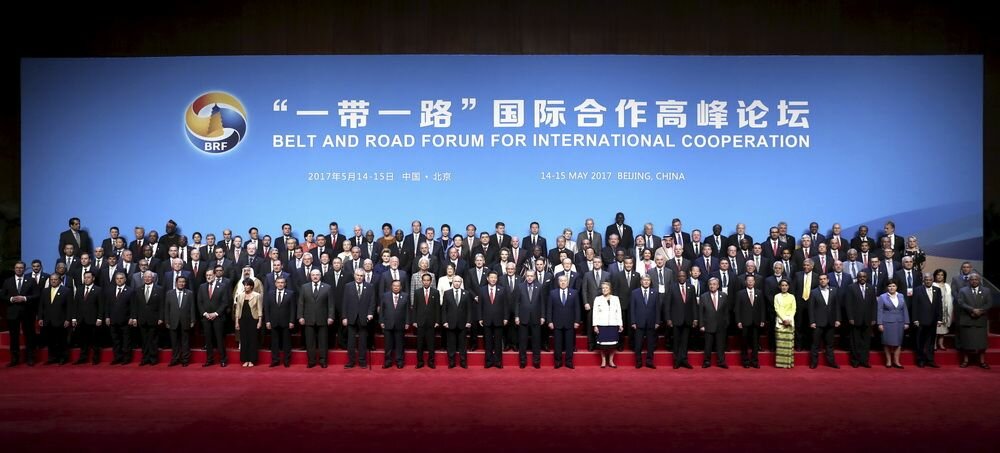
|
| The Belt and Road Forum for International Cooperation, Beijing, May 14–15, 2017 |
Based on this, the Forum tried to find possible options for coordinating the concept of the “One Belt — One Road” initiative with the actions of each of the participating countries that are being undertaken to develop national economies. In addition, the participants discussed the conditions needed to intensify integration processes, parliamentary cooperation and interaction in the struggle against extremism. There was also an exchange of views on the possibility of linking national economies in terms of combining the elements of the local infrastructure, removing obstacles to trade flows, and so on. An important element of the meeting was the Round Table attended by the heads of state, participating in the forum.
The program of the Forum emphasized China's intention to launch sustainable development of the integration processes in the South-East and Central Asia region, against the background of Western countries' “timeout” in the issues of globalization. At this, Beijing paid special attention to the development of international contacts in perspective and high-technology sectors of the economy, not forgetting to implement medium-term projects in which Chinese producers are interested. The development of cooperation in the innovation sphere means that China will create an action plan for scientific and technical development, create joint laboratories and scientific and technical parks. At the same time, the PRC will make efforts to develop a mutually beneficial trade and economic partnership with the participants in the “One-Belt-One Road” initiative.
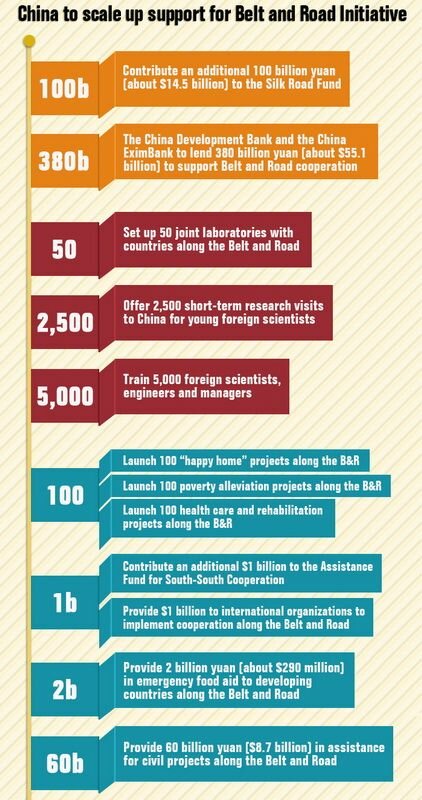
|
| China’s support for “The One Belt — One Road” Initiative |
To implement its intentions within the framework of the initiative, China is ready to spend significantly. Thus, the Chinese side has announced the following plans:
- to increase funding for the Silk Road Fund by approximately 14.5 billion US dollars;
- to conduct special lending for cooperation projects on development of the infrastructure, industry and financial sector through the national banking network (China Development Bank and Export-Import Bank of China) within the framework of the “One Belt — One Road” initiative in the amount of more than 55 billion US dollars;
- to provide financial assistance of approximately 9 billion US dollars to developing countries and international organizations that participate in the initiative;
- to create a China-Russia regional fund for cooperation, development and investment, to which the National Development and Reform Commission of China will allocate 14.5 billion US dollars. 1.45 billion US dollars from this fund will be used to strengthen cooperation between China's Northern provinces and Russia's Far East;
- to provide 290 million US dollars to address food problems in the countries that are located along the transport routes of the “One Belt — One Road” initiative;
- within the next three years to allocate 1 billion US dollars to the Assistance Fund for South-South Cooperation.
For successful implementation of the “One Belt — One Road” initiative, China has made significant efforts for it to be recognized at the UN level. Since the beginning of its implementation, the initiative has been repeatedly discussed at UN meetings, and UN Secretary General Antonio Guterres participated in the latest Forum. According to him, the Chinese initiative is “...is rooted in a shared vision for global development, and China has become a central pillar of multilateralism”.
The forum was accompanied by extensive information support, one of the elements of which was publication of a book about the initiative “One Belt — One Road” in 14 languages. The book contains a description of the main goals and key projects that are planned for implementation within the initiative. This book has become the next edition of the series of multilingual books “Keywords to Understand China”, which cover various aspects of life in the PRC.
Apart from China's substantial financial injections into the initiative “One Belt — One Road”, the main results of the Forum are as follows:
- The agreement on creating a system for ensuring stable financial support and hedging the risks of implementing the “One Belt — One Road” initiative;
- The common position regarding the use of environmentally friendly technologies in production;
- The increase in the number of countries and international organizations that have signed a cooperation agreement under the “One Belt — One Road” initiative. According to the results of the Forum, 68 countries and organizations, that have agreed to hold a similar forum in 2019, have such an agreement;
- The Memorandum of Understanding with the participants of the initiative was signed by Mongolia, Pakistan, Nepal, Croatia, Montenegro, Bosnia and Herzegovina, Albania, Timor, Singapore, Myanmar and Malaysia;
- The establishment of cooperation with international organizations at the United Nations, in particular: the United Nations Development Programme, the United Nations Industrial Development Organization, the United Nations Human Settlements Programme, the United Nations Children's Fund;
- The agreement on the development of cooperation in the sphere of economy and trade signed with 30 countries, including: Vietnam, Pakistan, Sri Lanka, the Philippines, Indonesia, Uzbekistan and Belarus;
- The agreement signed on the establishment of the Asian Financial Cooperation Association.
The work of the Forum ended with the signing of a joint communiqué, which contains 76 directions of interaction in such sectors as: international politics, trade, finance, humanitarian ties.
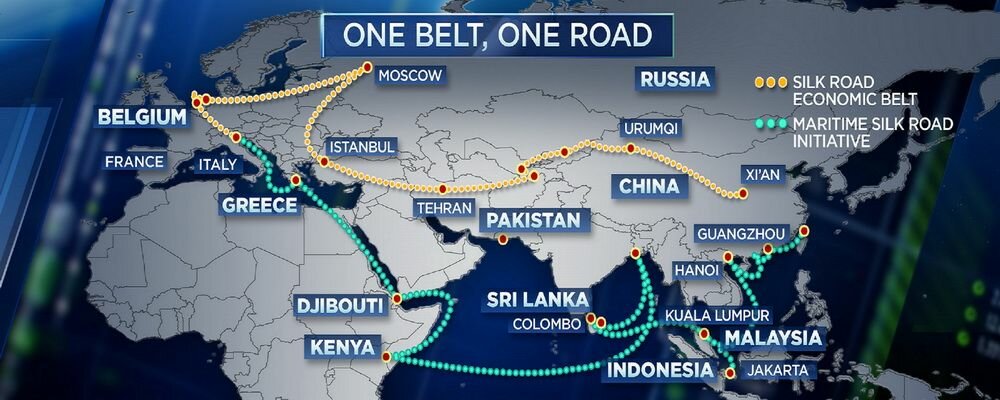
|
| “The One Belt — One Road” Initiative |
Preliminary assessments of the “One Belt — One Road” Forum show that China's leadership methodically and purposefully concentrates its efforts to advance the process of globalization, to which the collective West today demonstrates a rather cool attitude. Such efforts allowed China to offer the world community a project for establishing global economic cooperation. These efforts met a response in a significant number of countries that are actively seeking opportunities for integration into the world economy. So, initially being an initiative of regional cooperation, “One Belt — One Road” has acquired a global character, allowing China to take a stronger position in the world. At this, China is the initiator, organizer and financial donor of the new format of cooperation in Eurasia.
In case of dynamic development, the initiative will create preconditions for the emergence of a new center for the growth of the world economy. However, a long-term dynamic development within the framework of the initiative can be ensured only if developed countries of the West participate in it, which would allow the newest technologies to come to Asian countries.
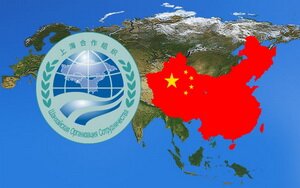 Strengthening regional stability using the capabilities of the Shanghai Cooperation Organization (SCO) is seen by China as an important condition for strengthening its role in Asia. The creation of the Organization was caused by the need to ensure a predictable development of relations with the countries of Central Asia after the collapse of the Soviet Union, first of all in the sphere of security. Today, along with addressing issues related to security, the Organization's capabilities serve to expand economic partnership between the SCO member countries. In particular, recently Beijing has actively been supporting the increase in the number of participants in the Organization, which the Chinese side views as an economic market with great potential. Thus, the PRC pursues a policy aimed at easing trade barriers between the member countries and the SCO's partners with further creation of a common economic space. In turn, the countries (participating in the cooperation within the Organization) treat China as a strong partner, with which dialogue is needed, and also as a source of investment and technology.
Strengthening regional stability using the capabilities of the Shanghai Cooperation Organization (SCO) is seen by China as an important condition for strengthening its role in Asia. The creation of the Organization was caused by the need to ensure a predictable development of relations with the countries of Central Asia after the collapse of the Soviet Union, first of all in the sphere of security. Today, along with addressing issues related to security, the Organization's capabilities serve to expand economic partnership between the SCO member countries. In particular, recently Beijing has actively been supporting the increase in the number of participants in the Organization, which the Chinese side views as an economic market with great potential. Thus, the PRC pursues a policy aimed at easing trade barriers between the member countries and the SCO's partners with further creation of a common economic space. In turn, the countries (participating in the cooperation within the Organization) treat China as a strong partner, with which dialogue is needed, and also as a source of investment and technology.
For these reasons, with the use of various forms of cooperation, including membership, dialogue partnerships, observer states and countries that have applied to participate as observers, nearly twenty countries of Central, Southern and South-Eastern Asia, and also the Caucasus have got united around the Organization.
The PRC's priority attitude to the intensification of economic cooperation is opposed by Russia, which sees the SCO solely as a means for combining efforts in fighting extremism in its various manifestations. In order to strengthen cooperation in security matters within the SCO, V. Volodin, Chairman of the CSTO Parliamentary Assembly, on 26 March 2017, called to discuss with the structures and members of the SCO an issue of counteracting hybrid wars. Russia took this position, fearing an increase in Chinese economic expansion in the Central Asian countries.
Besides, tensions between the PRC and Russia arise because of Moscow's initiatives to create supranational organizations with a partial delegation of sovereignty. Beijing, which categorically opposes any infringement of China's sovereignty, is negative about such appeals.
Nevertheless, following the principles of foreign policy, China promotes the constructive development of Sino-Russian relations. Thus, during the Summit of the Heads of State of the Shanghai Cooperation Organization (June 8–9, in Kazakhstan), among all documents, the SCO Convention on Countering Extremism and the Statement of the Heads of the SCO Member States on Joint Counteraction to International Terrorism were adopted. Besides, Xi Jinping, commenting on the beginning of China's presidency in the SCO (2017–2018), proposed the development of a program of cooperation to fight the “three forces of evil” for the next three years. This approach fully meets Russia's interests in the Organization.

|
| The meeting of the Heads of States of the Shanghai Cooperation Organization, Astana (Kazakhstan), June 8–9, 2017 |
At this, China continued to fulfill its tasks consistently. Speaking at the Summit, Xi Jinping suggested the development of a five-year Action Plan for the implementation of the provisions of the Treaty on Long-Term Good-Neighborliness, Friendship and Cooperation of the SCO Member States (to determine the areas of cooperation between the countries), to form institutions for regional economic cooperation, and to determine the conditions for cooperation of the media.
It should be noted that after India and Pakistan's joining the SCO, the Organization will have to adapt to the new circumstances of its functioning. In particular, China during its presidency will face the need to make efforts to maintain the stability of the Organization against the background of tense Indo-Pakistani relations.
As part of the pragmatic development of relations with the world's “centers of power”, the official Beijing has made special efforts to build a strategic dialogue with the United States of America, as well as productive ties with the Russian Federation and the European Union.
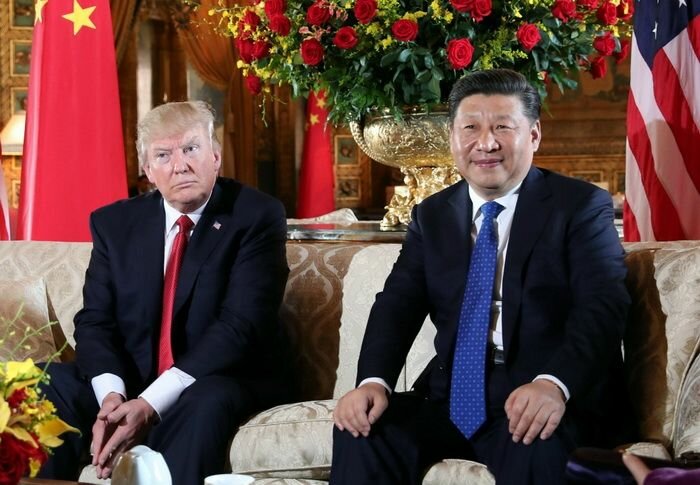
|
| The first official meeting of Xi Jinping and Donald Trump, Florida, April 6, 2017 |
The development of a strategic dialogue with the United States of America remains the most important direction of the PRC's foreign policy. In the situation of “political turbulence” in international relations caused by the strengthening of populist positions in Western countries, the correction of the US foreign policy by President D. Trump and Russia's aggressive foreign policy, the official Beijing is paying greater attention to building relations with the new American administration. Beijing's special attention to Sino-US relations can be explained by the desire to take advantage of the situation in order to take its place among world powers.
In particular, on 6–7 April 2017, President Xi Jinping paid a visit to the United States and had his first meeting with D. Trump. The fact that the Chinese side paid special attention to establishing relations with the new American leadership is evidenced by the haste of organizing the visit of the Chinese leader, and China's President's second in a row visit to the USA territory, which is contrary to the diplomatic protocol. It is quite possibly, such a haste was dictated by China's desire to get an “objective assessment” of the new US President as soon as possible and to establish personal contact between the heads of state. Establishing such contact at the very beginning of D. Trump's presidential term meant creation of the basis for predictable and conflict-free development of bilateral relations, which fully complies with the principles of China's foreign policy.
The first, after the change of the US leadership, Sino-US summit was used by Beijing to form the new US President's positive perception of the PRC's main foreign policy aspirations. As “Xinhua” Chinese agency pointed out, Xi Jinping urged the United States to join the “One Belt — One Road” initiative, which the previous US administration perceived as competitive with Washington's strategy to strengthen the USA's role in the Asia-Pacific region.
Besides, the Chinese leader emphasized the importance of intensifying military cooperation between the USA and the PRC, including at the highest level, to prevent conflicts involving the armed forces of the two countries. Given this position, the Chinese state media called the meeting of the leaders of the two countries a good example in terms of preventing confrontation, which throughout the world was considered inevitable.
A distinctive peculiarity of the meeting of the Chinese and American leaders was its informality. Such a format allowed the participants not to follow the protocol and avoid adopting a joint statement on its results. Thus, the parties would be “on the safe side” in case, if the negotiations ended in big differences.
This approach was used because of a rather extensive list of issues on which the parties have their own views. Today, such problems include: relations between countries in the spheres of economy, trade and security; monetary policy, protectionism in the economy; the DPRK's nuclear missile program; the PRC's policy in the South China Sea; and the deployment of US missile defense systems in the region.
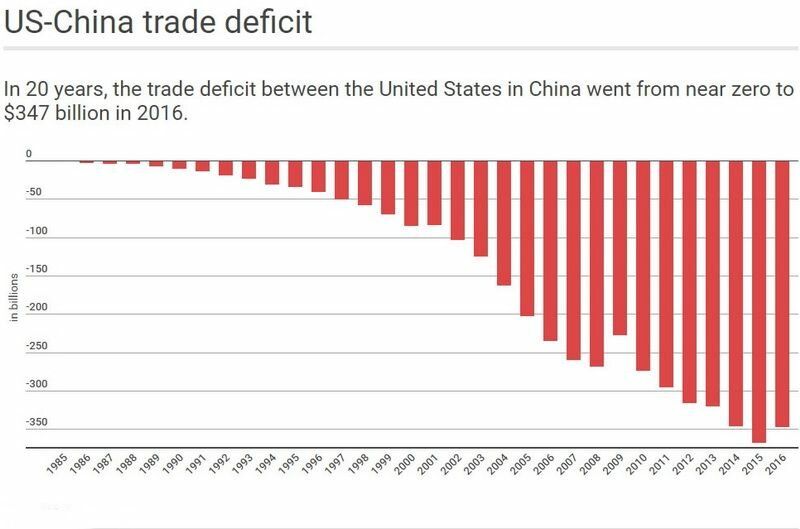
|
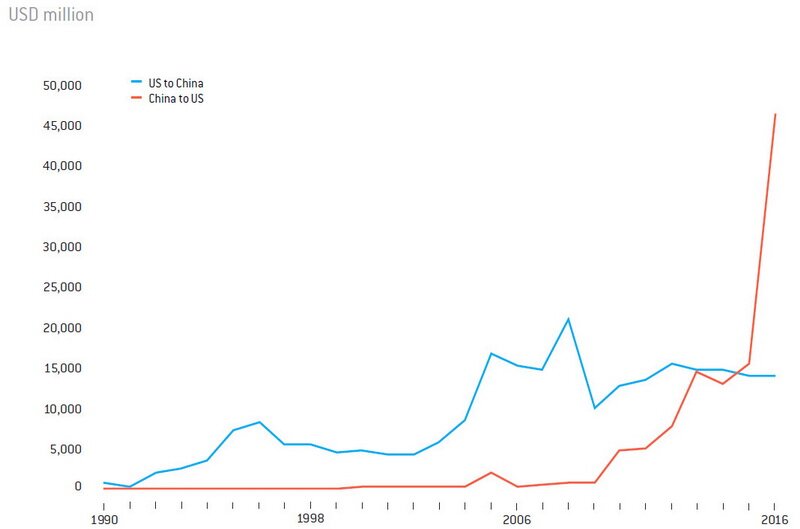
|
| US–China trade deficit, USD billion | US-China bilateral foreign direct investments (FDI), USD million |
In this context, China has demonstrated its intention to make significant concessions to the USA, such as lifting of the ban on imports of beef (established since 2003), increase in the imports of agricultural products and the scale of investment in infrastructure projects in the US territory. According to US Commerce Secretary W. Ross, the Chinese side announced its intention to reduce the China-US trade imbalance, hoping to reduce the rate of inflation in China. Applying such frankness in the negotiations with the Americans, the Chinese delegation once again demonstrated its being interested in the constructive development of bilateral relations. At the same time, the effectiveness of Sino-US cooperation after the talks between Xi Jinping and D. Trump will be essessed in the report of the joint working group on the results of the hundred days of activity in the above-mentioned spheres.
At the same time, during the meeting the Chinese delegation made it clear about its readiness to change attitudes to international security issues, which may also indicate Beijing's intention to establish new relations with Washington. Such problems include:
- resolving the Syrian conflict. Xi Jinping not only did not condemn the American strike at Shayrat air base, but called the USA's actions the forced ones in the situation where chemical weapons against the peaceful Syrian population were used. At the same time, the PRC continues to insist on seeking a political solution to the conflict in Syria. It is not excluded that China can support the change of the B. Assad regime in exchange for changing the USA's position on the problem of the South China Sea;
- denuclearization of the Korean Peninsula, regarding which China pledged to continue to comprehensively implement the UN Security Council's resolutions on the DPRK. According to US Secretary of State R. Tillerson, during the talks, the Chinese side agreed to closer cooperation with Washington on the issue of putting an end to the North Korean nuclear missile program.
To resolve the North Korean nuclear problem as soon as possible, the US side used the promise to develop trade relations with the PRC. In his statement, D. Trump pointed out that he told Xi Jinping about the possibility of concluding a trade agreement beneficial for the Chinese side if China “...gets rid of the threat from the DPRK or somehow influences it”. Earlier, during the preparation of the Sino-US summit, R. Tillerson stated that the “era of strategic calm” had come to its end. In his turn, D. Trump stated about the possibility to act independently to resolve the North Korean nuclear problem, if the official Beijing refuses to use its strong influence on Pyongyang for this.
However, the speed with which the US President expected to reach an agreement on the DPRK nuclear program is clearly ahead of China's readiness to take a decision with regard to North Korea. In particular, D. Trump decisively strengthened the US military presence in South-East Asia by placing in the region an aircraft carrying strike group led by the “Carl Vinson” aircraft carrier and elements of the US missile defense system in South Korea (this process is planned to be completed by the end of 2017). Due to this, the US side was a “step ahead” in the issue of military deterrence of its opponents in the region. In fact, actions of D. Trump's testify to his intention to make Beijing develop relations on his terms.
Having procrastinated effective measures against the DPRK, the official Beijing has well lost the opportunity to solve the nuclear problem in the Korean Peninsula and at the same time to maintain the status quo in the region in the military sphere. Therefore, having reacted negatively to the deployment of American missile defense system in South Korea, China continued to insist on a peaceful settlement of problems with North Korea and in every way trying to avoid direct participation in resolving this crisis. In his telephone conversation with D. Trump on 24 April 2017, Xi Jinping expressed the hope that “...all sides will show restraint and avoid doing things that could lead to an escalation of tension”.
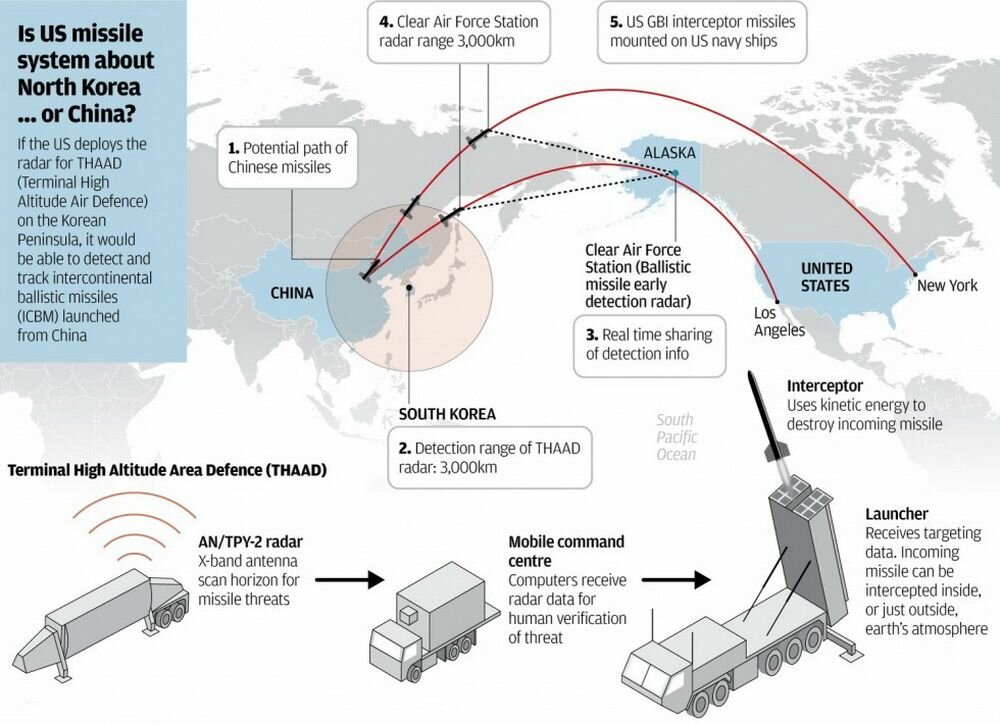
|
| Why China objects to the deployment of the THAAD missile defense system in South Korea? |
At this, some publications in the Chinese media are aimed at distancing China from the North Korean problem, emphasizing Beijing's lack of influence on the leadership of the DPRK. According to Chinese analysts, it would be wrong to shift the responsibility for the tension in the Korean Peninsula to China, and the North Korean nuclear issue is a consequence of the US-North Korean relations, in particular the absence of a peace treaty between the United States and the DPRK for more than 60 years.
Such “stove-piping” once again shows that the future of the Sino-US strategic dialogue will be complicated due to Beijing's “hybrid” approach to security problems, which is very similar to Russia's “hybrid” aggression against Ukraine.
At the same time, the Armed Forces of the People's Republic of China took measures to increase their combat readiness in order to reduce the response time to “extraordinary circumstances related to the DPRK”. At this, the direction of such a reaction of the Chinese side remains unclear.
It is possible that the current US leadership's tough unilateral actions will prompt China's leadership to more actively participate in the settlement of international conflicts.
In general, the main results of the Sino-US summit are as follows:
- Exchange of information on approaches to the realization of national interests, which, together with the establishment of personal contacts and working relations, is extremely important for further development of relations between US President D. Trump, who has no experience in ruling the state, and President of the People's Republic of China Xi Jinping, who has the decades-long experience of moving “up the ladder” of the state hierarchy of China. According to Wang Yi, the Foreign Minister of China, Beijing focused on its principled position on Taiwan, Tibet and the problem of the South China Sea, and also announced the hope that the USA will be guided by the principles of the three Sino-US joint communiqués /Shanghai Communique, China-USA communique on the establishment of diplomatic relations and the Communique of August 17/ and by the policy of one China. In fact, the Chinese side outlined its terms under which it will contribute to the fruitful development of Sino-US relations;
- Recognition of joint responsibility for the safe development of international relations and prevention of armed conflicts. The sides pointed out the need to maintain contact and coordinate actions on the most important international problems. Based on this, an agreement was reached on a plan for exchanges between the two countries at a high level. In particular, US President D. Trump accepted an invitation to visit the PRC before the end of this year. Besides, the leaders of the two countries agreed to maintain contacts on all available channels of communication;
- Establishment of high-level cooperation in foreign policy and security, economic issues, interaction between law enforcement agencies and in the field of cybersecurity, as well as social and humanitarian issues. By agreement between the leaders of the two states, the priority efforts of the PRC and the USA will be focused on interaction in matters of politics, security and economy;
- An agreement on the development of cooperation at various levels in the spheres of trade and investment, settlement of trade and economic contradictions, struggle against illegal migration, search for persons who fled from justice outside the country, return of illegally transferred funds abroad, and so on.
To understand the official Beijing's actual attitude to the current state of China-USA relations, it is necessary to pay attention to China's information support to the meeting of the leaders of the two countries. In particular, the Chinese leadership represents Xi Jinping's visit to the USA as positive. According to the Minister of Foreign Affairs of China, Wang Yi, the meeting of the leaders of the two countries turned out to be “very important, timely, effective, contributing to mutual understanding, increasing mutual trust”. Besides, according to his assessment, the China-USA summit was “a good start to a new period of relations”. Also, according to the representatives of the Chinese leadership, the meeting between Xi Jinping and D. Trump gave “a constructive leitmotif to the advancement of Sino-US relations” and determined the vector of their future development. The first meeting of the leaders of the two countries “signaled” that “China and America can become excellent partners for cooperation”, despite the existing disagreements.
In turn, the positive changes in the American approach to the development of relations with the PRC are also evidenced by the apparent constructive tone of relationship between the two countries. Thus, following the results of the talks, D. Trump refrained from harsh words addressed to Beijing and stated about “actual progress in relations with China”. This happened after D. Trump, in his usual manner, had called China a “currency manipulator” and declared his unwillingness to put up with the PRC's economic policy, which creates preconditions for maintaining the trade deficit.
D. Trump also shows a desire to quickly achieve results in resolving problematic issues in relations with China in the economic sphere. The US administration's refusal to participate in the Trans-Pacific Partnership should be viewed not only as a rejection of undesirable foreign economic projects, but rather as the American side's intention to “water-down” the relations with China in order to re-approach the building of Sino-US relations in the APR.
It is not excluded that the PRC will agree to open its market for American products and will increase the scale of investing into the US economy. However, in principled matters of strategic importance, Beijing has no intention of conceding. This concerns, above all, the expansion of China's influence in Asia.
The above-mentioned peculiarities of the negotiations and the positions of the parties after their completion, clearly indicate the United States and China's being interested in the development of mutually beneficial cooperation. The USA's innovative economy and the PRC's economy with a powerful production potential are prerequisites for a long and effective Sino-US strategic dialogue. At this, both states need in developing of world economic relations on the principles of openness and inclusiveness. While at the same time, further development of the dialogue between the USA and China will greatly depend on their views on the “zones of influence” and their ability to find a common solution regarding the status of such zones.
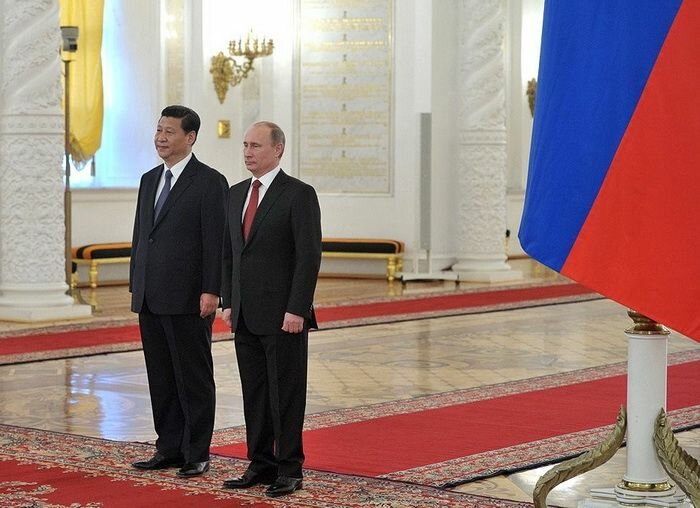
|
| The first state visit of the President of the PRC Xi Jinping to Russia, March 22, 2013 |
China's being interested in maximizing the benefits from a strategic dialogue with the USA determines the official Beijing's today's active position in relation to the Russian Federation. Current Chinese-Russian relations are characterized as pragmatic versatile cooperation with a high intensity of contacts at the highest level. In particular, Xi Jinping's very first visit in the post of the President of the PRC was to Russia. Commenting on this visit, Vice Premier of the State Council of the People's Republic of China, Wang Yang, spoke about the great importance that China attaches to relations with the Russian Federation.
Today, the exchange of visits between the heads of the two states is taking place regularly. in 2016 alone, there were five meetings between Xi Jinping and V. Putin. Against the background of the dynamic change in the international situation, the Chinese and Russian sides paid special attention to the contacts between the Russian President and the PRC President in 2017. Thus, V. Putin took part in the opening of the “One Belt — One Road” Forum on 14 May 2017, after which he met with Xi Jinping. During the meeting, the leaders of the two countries paid attention to the issue of combining the opportunities that the “One Belt — One Road” and the Eurasian Economic Union provide to the countries of Asia. The initiator of uniting such opportunities was Russia, which is trying to use any chance for developing relations with Asian countries.
In turn, the Chinese side is preparing the PRC President's state visit to Russia, scheduled for July 4, 2017. It is not excluded that the plan to hold a meeting between Xi Jinping and V. Putin in Moscow on the US Independence Day has a symbolic meaning and is intended to draw Washington's attention to the special relations between Beijing and Moscow. In this context, we should recall the statement made by the Head of the Standing Committee of the National People's Congress of China, Zhang Dejiang, who, while staying in Moscow in early 2017, that the Chinese-Russian contacts “...are becoming more and more global and meaningful”.
Despite the fact that the strategic cooperation between the two countries has been about two decades old, since the mid-1990s to be exact, the intensification of bilateral relations began after the ratification in 2006 of the treaty on the settlement of border claims. In accordance with the treaty, the disputed territories on the Sino-Russian border were given to China. At the same time, Beijing and Moscow began combined activities to “extrude” the USA from the countries of Central Asia. In particular, thanks to the efforts of the People's Republic of China and the Russian Federation, a declaration was adopted at the SCO forum that urged Washington to determine the deadlines for the termination of US military bases in the Central Asian countries, and the practice of joint Chinese-Russian military exercises began.

|
| China-Russia Military Exercises (2012–2016) |
At this, military and military-technical cooperation with the Russian Federation is an important part of Beijing's foreign policy. The opportunities provided by this cooperation are used by China to establish parity with the USA in developing a dialogue on security issues. Within the framework of their military cooperation, the Chinese and Russian sides have gained considerable experience in conducting joint exercises of various types of Armed Forces. Among the variety of tasks that the Chinese side sets for itself in conducting such exercises (acquiring the experience of preparing and conducting military operations and combat operations, studying the Russian Armed Forces as a possible adversary, improving the training of personnel to use weapons and military equipment of Russian production, etc.), China pays special attention to creation of an image of allied interaction between the Armed Forces of the PRC and the Russian Federation. In this way Beijing hopes to get a possible counterbalance to the military potential of the USA and its allies in the APR.
Sino-Russian military-technical cooperation remains an important channel for the supply of weapons, military equipment and military technologies to China, which are used to strengthen the military power of the PRC. The main areas of cooperation between the two countries in this sphere are determined by the China-Russia Intergovernmental Commission on Military Technical Cooperation, which has been operating since 1992. Since that time, a significant number of contracts for the supply of Russian-made weapons and military equipment in the interests of the People's Liberation Army of China (PLA) have been implemented. In the mid-2000s, there was a decrease in the scope of Russian arms purchases for the PLA due to the increase in the nomenclature of manufactured weapons and military equipment in China itself.
Today, China is again one of the five largest importers of arms and military equipment from Russia. According to the Federal Service for Military-Technical Cooperation of the Russian Federation, the PRC's order book of Russian armament is more than 8 billion US dollars, which is about 15 % of the export of Russian arms and military equipment. This happened at the expense of contracts for the supply to the PRC of anti-aircraft missile defense complexes S-400, Su-35 fighters and aircraft engines. China needs ready-made Russian weapons to meet the current needs of the PLA, which are determined by the dynamic development of the military-political situation in the APR. In other words, the PRC's Armed Forces must be ready to carry out combat missions, without waiting for weapons from Chinese manufacturers.
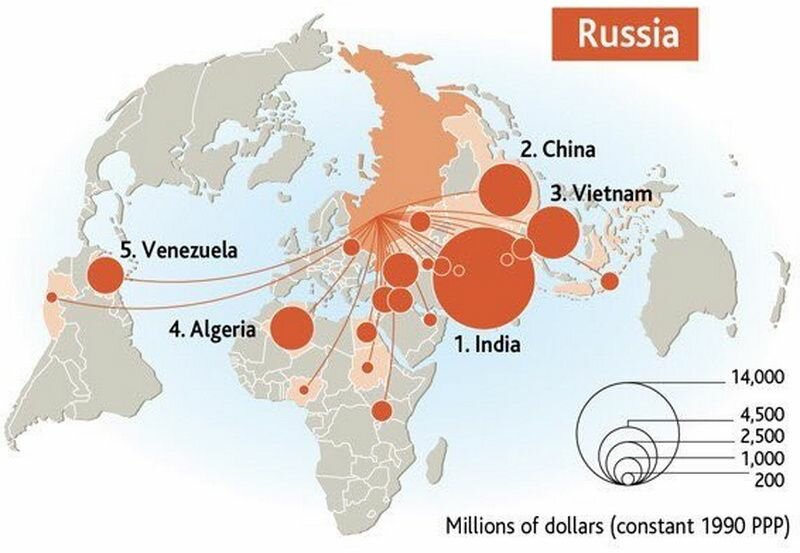
|
| China is the second largest importers of Russian arms, USD million |
At the same time, such a situation is temporary. As the Chinese defense industry develops, the scale of China's purchase of ready-made weapons in Russia will be decreasing. The only thing that will continue interest China will be Russian military technologies.
In its turn, China is becoming a supplier of components for the Russian military industry. In the context of international sanctions and the need to implement the import substitution program, the Russian side has increased the scale of purchases of Chinese components for the production of weapons and military equipment. The Russian Defense Industry's special attention is drawn to the supply of Chinese power units for military ships that cannot be equipped with engines due to embargoes and the severance of ties with Ukrainian producers.
Changes in the Sino-Russian military-technical cooperation testify to the strengthening of China's independence in solving security problems in the Asia-Pacific region. This, in turn, gives Beijing confidence in defending national interests in Asia, which will inevitably lead to increased contradictions with the Russian Federation.
Proceeding from this, the Chinese Institute of the Asia-Pacific and World Strategy of the Academy of Social Sciences in the “Blue Book”, published in 2013, presented an assessment according to which the establishment of a truly allied relationship between the PRC and the RF is considered unlikely.
A reason for the intensification of rivalry between China and Russia in Asia is also Russia's economic backwardness, which accelerated after the introduction of international sanctions in response to Moscow's aggressive foreign policy. As a result, Russia is becoming increasingly incapable of developing the Far East and acting as a guarantor of stability in the region. If this trend persists, China will treat Russia as a supplier of resources, which is incapable of implementing a strong foreign policy in Asia.
As a confirmation of this development of Chinese-Russian relations, one can consider Beijing's demand to Moscow to strengthen cooperation in the energy sector, made by member of the Politburo Standing Committee of the CPC, Vice Premier of the State Council of the People's Republic of China, Zhang Gaoli, during the meeting with Gazprom CEO A. Miller in Beijing on 15 February 2017. According to him, the Chinese side expects that the projects for the supply of crude oil, the construction of the gas pipeline along the eastern route and the Yamal LNG project will be implemented in a timely manner. In addition, Beijing hopes for increase the scale of energy supplies to China and the development of energy infrastructure in the Far East.
According to Russian experts, there is a threat that China will start having territorial claims in relation to the Far Eastern region of Russia. Thus, there is a possibility that using the law of the Russian Federation from 2014 No. 473-FZ “On the territories of advanced social and economic development in the Russian Federation”, China will be able to initiate the joint use of the territory of the Far East and Siberia. Chinese experts' assessments of the low effectiveness of economic policy and the use of natural resources, which take place in the Russian Far East, can testify to the possibility of such an initiative.
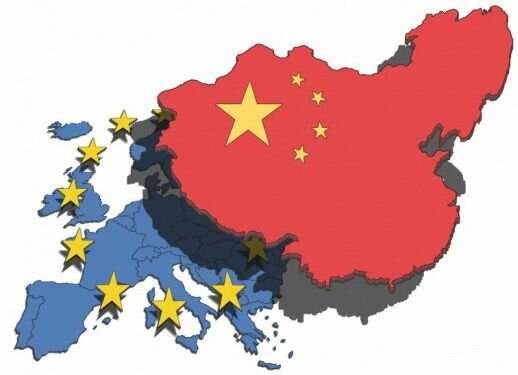 The development of relations between the PRC and the European Union in recent years has been significantly influenced by the strengthening of China's position in the world system of political and economic relations.
The development of relations between the PRC and the European Union in recent years has been significantly influenced by the strengthening of China's position in the world system of political and economic relations.
In particular, having an essentially increased economic potential, China is making efforts to diversify its relations with the European Union. This approach, in general, is in line with the Strategic Plan for the Development of Sino-European Cooperation until 2020, signed by the parties in 2013.
Taking into consideration the above-mentioned plan, during Xi Jinping's first visit to the EU countries in the spring of 2014, the spheres of cooperation between the PRC and the EU were defined, which include:
- development of a comprehensive strategic partnership, which began in 2003;
- deepening economic cooperation in traditional sectors, as well as in the sphere of scientific and technical innovations;
- improving interaction and coordination of decisions in the course of reforms in the PRC and EU with a view to ensuring an even development of cooperation for a long period of time;
- developing cultural ties and humanitarian cooperation in the interests of the successful implementation of economic projects and strengthening political trust between the parties.
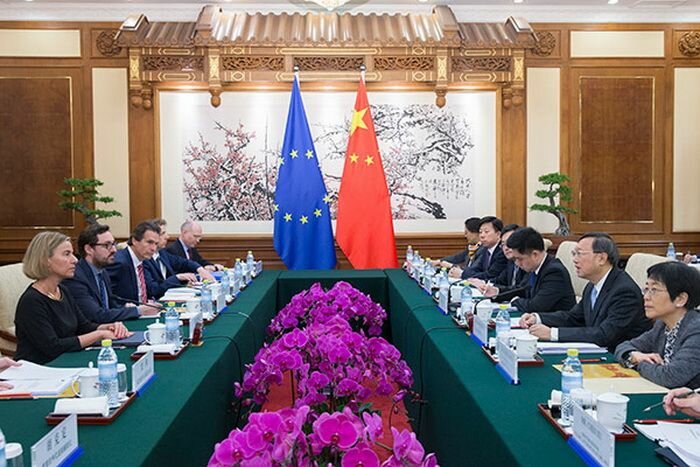
|
| 7th China—EU Strategic Dialogue, Beijing, April 19, 2017 |
Against the background of Great Britain's withdrawal from the EU and strengthening of populist positions in European structures, the PRC turned to the use of the Sino-European strategic dialogue to influence the internal policy of the European Union. During the last round of dialogue (the 7th in a row), which took place in April 2017 in Beijing, the Chinese side stressed its support for the preservation of unity and integration processes in Europe. A month earlier, at the press conference of Premier of the State Council of the People's Republic of China, Li Keqiang stated that “...this is positive for globalization, a multipolar world and a variety of civilizations”. In general, the Co-Chairmen of the meeting of the Strategic Dialogue — China's State Councilor Yang Jiechi and the EU High Representative for Foreign Affairs and Security Policy F. Mogherini pointed out the mutual interest in deepening economic and political cooperation.
Xi Jinping also spoke in his telephone conversation with the new French President E. Macron on May 9, 2017, about the need to preserve the unity of the European Union and integration processes. At this, the Chinese leader spoke positively about France's participation in the initiative “One Belt — One Road”.
In doing so, China is trying to get the EU to make predictable and balanced decisions on international cooperation. To some extent, this indicates the lack of confidence of Beijing in the objectivity of decision-making by European leaders.
The dominant reason for China's being interested in maintaining the stable development of the European Union is the desire to strengthen economic ties with the EU. As a result, in current circumstances the European Union has become China's largest (after the USA) trade and economic partner.
Among China's main tasks in matters of economic cooperation with the EU should be noted the continued stability of the European market, increase in the scale of Chinese manufacturers' presence on it, and Chinese corporations' access to production technologies and scientific and technical developments. In carrying out these tasks, China seriously counts on Europe's being interested in attracting Chinese investments and increasing the number of tourists from China that contribute to the post-crisis recovery of the EU economy.
Among the most effective ways to enhance China's cooperation with the EU, which look more like China's penetration into the EU without parity, the following should be noted:
-
maintaining a high level of contacts through President Xi Jinping's regular visits to Europe (in 2014 and 2017) and his telephone talks with the leaders of European countries. China pays special attention to contacts with the leaders of most influential countries of the European Union and the leaders of international organizations;
China’s foreign direct investments (FDI) in the economy of the EU countries, EUR million - creation of conditions for inviting European countries to participate in the initiative “One Belt — One Road”. In case of an interaction with the European Union in the implementation of this initiative, China's opportunities in the European market will increase significantly;
- establishing a joint free trade area between China and the EU, initiated by China in 2015, but left by the EU without due attention;
- increasing the role of economic investment. Analysis of the indicators of this activity over the past five years shows a decrease in the relevance of the trade between China and the EU by ready-made goods in favor of mutual investments into production. At this, the volume of Chinese investments into the economy of the EU countries today significantly exceeds the European investments in the PRC. The bulk of Chinese investments go to high-tech and prospective production;
- establishing direct economic ties with the countries of Central, Eastern and Southern Europe. One of the forms of such cooperation was the regular holding (since 2011) of trade-economic forums of the PRC and countries of Central and Eastern Europe. The parties pay great attention to the development of the transport infrastructure and energy system of South-Eastern Europe. These directions were chosen due to tying up China's activities on the European direction to real needs of the countries of Central, Eastern and Southern Europe. During the 6th Forum, which was held in Riga in November 2016, Premier of the State Council Li Keqiang initiated an increase in bilateral trade, accelerated development of transport and communication interconnectedness, deepening cooperation in the production sector, renewing the models for financial cooperation, and intensifying cooperation in the field of tourism;
- concentrating considerable efforts on deepening cooperation with most developed and influential countries of the European Union. The most active economic cooperation is developing between China and the Federal Republic of Germany, which, in 2016, became China's most important trading partner, displacing the United States from the first place. The volume of export-import transactions between the countries in 2016 amounted to 170 billion Euros (France — 167 billion Euros, the USA — 165 billion Euros).
At the same time, China is most interested in cooperation with Germany in the spheres of investment and technology. According to Chinese experts, innovative cooperation between China and Germany will determine future relations between the two countries.
In particular, the Chinese side is investing into the most technologically advanced firms and enterprises. According to the consulting Ernst & Young company, in 2016, China spent more than 11 billion Euros on acquiring companies in Germany, which is 20 times more than the similar spending in the previous year. In total, in 2016, the Chinese side purchased about 60 German companies (approximately 20 companies more than in 2015).
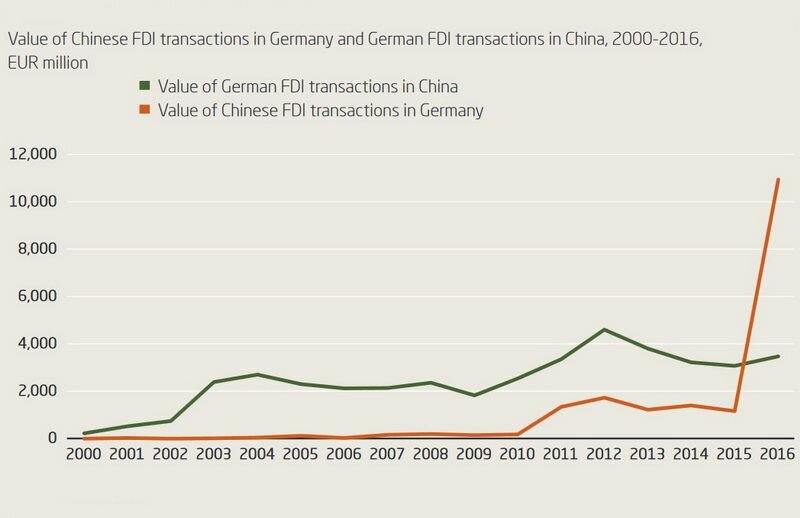
|
| China-Germany bilateral foreign direct investments (FDI), EUR million |
However, such activity of China causes growing suspicion in Germany for the following reasons:
- the Chinese side's special attention to enterprises that have access to technologies that can be used in the production of weapons and military equipment. Chinese investors show great interest to the technologies of the production of the element base for computer and robotic equipment;
- China's limiting German investments in Chinese industry. In accordance with the changes in investment policy that occurred in 2015, the acquisition by foreign businesses of assets in the PRC is prohibited in 38 administrative districts and economic zones. While in most of China's territory joint ventures are allowed to be established.
Given these circumstances, the leadership of the FRG has resorted to the practice of prohibiting the sale of high-tech companies. Also, the German side has suggested to the European Commission to consider the possibility of expanding the powers of the governments of the EU member states (with ability to terminate acquisition by non-European firms of assets in strategically important industries).

|
| Xi Jinping’s meeting with Finnish President Sauli Niinisto, Helsinki, April 5, 2017 |
Recently, China has been stepping up efforts to use bilateral cooperation with the Nordic countries of the EU to implement national interests in the Arctic region. In this regard, the Chinese side shows an active interest in developing contacts with countries presiding in the “Northern Council” organization.
During his visit to Finland in April 2017, China's President Xi Jinping invited the leadership of that state to use the Chinese capabilities for stable development of the national economy in exchange for Finnish assistance in the development of cooperation between China and the Nordic countries in the development of the Arctic region. In this respect, China is counting on Finland's presidency in the “Northern Council” (since 2017). Besides, the Chinese delegation proposed to develop cooperation within the framework of the “One Belt — One Road” initiative, as well as in the spheres of scientific and technical innovation, energy conservation, investment, clean technologies, etc.
To be continued…

